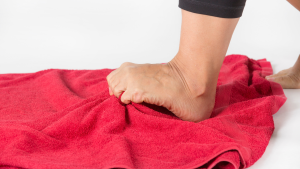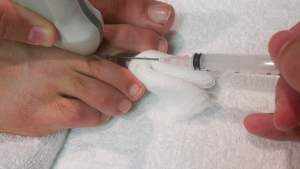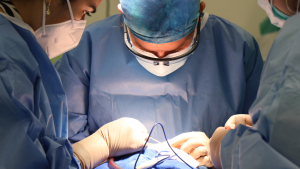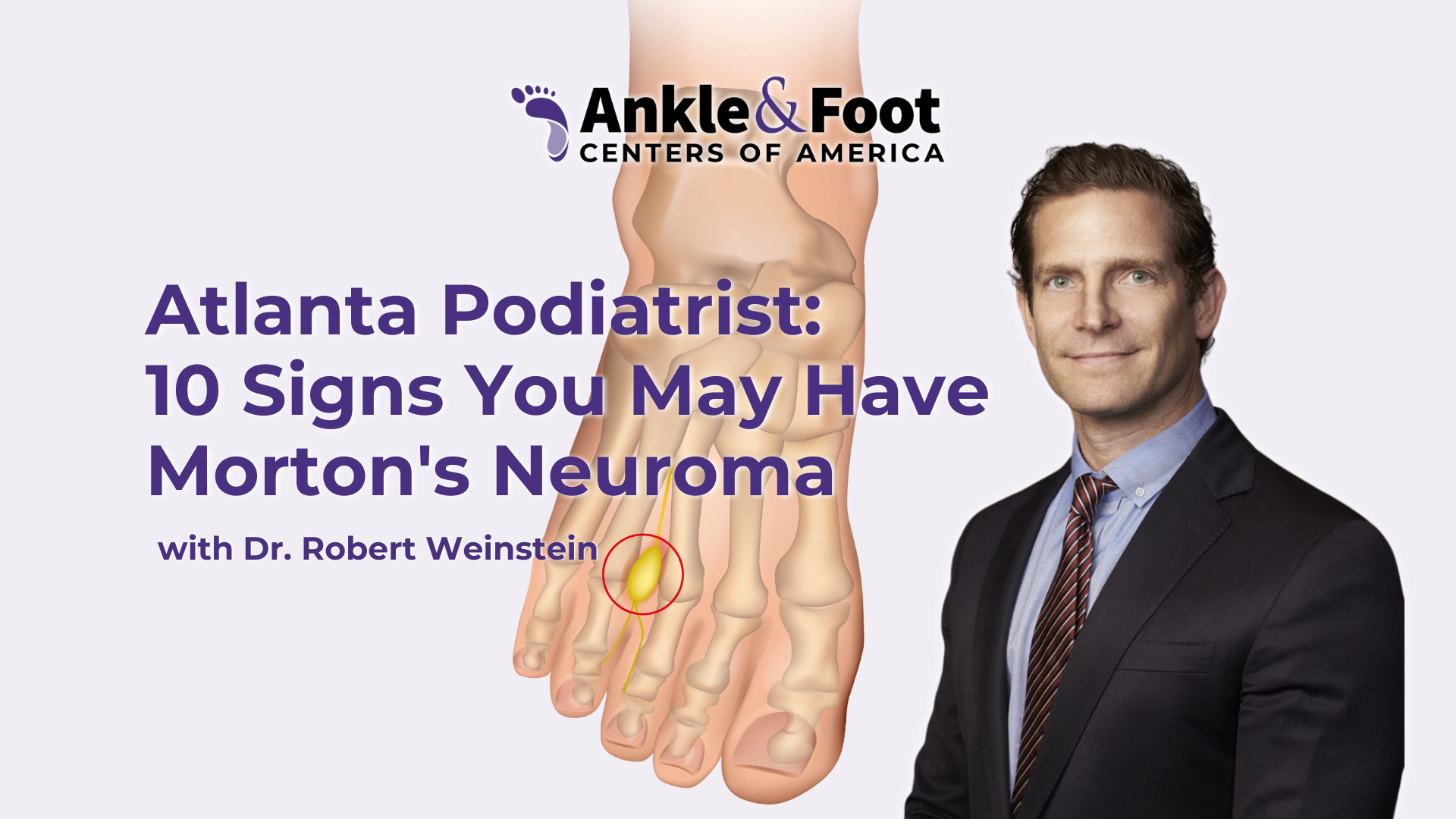Table of Contents
Introduction
Ever felt a sharp, unrelenting pain in your foot that just won’t quit? This could be more than just fatigue from a busy day—it might signal Morton’s Neuroma, a nerve condition notorious for severe forefoot pain. Often, it slips under the radar until it becomes unbearable. In this article, we’re diving into the top 10 signs of Morton’s Neuroma and highlighting when it’s time to consult a podiatrist.
It’s crucial to recognize early symptoms like tingling toes or the sensation of stepping on a pebble. Morton’s Neuroma can severely impair your mobility and diminish your quality of life. But relief is within reach. We’ll guide you through each sign and explore effective treatments—from excision and physical therapy to surgery—to help you reclaim your comfort.
Tingling Sensation in the Toes
A tingling sensation in the toes, especially between the third and fourth toes, is an early sign of Morton’s Neuroma. This sensation might feel like pins and needles or as if your toes are falling asleep. The cause? It’s usually the thickening of tissue around the nerves leading to your toes, which compresses and irritates the nerve itself.
This symptom indicates that the nerves in your foot are being compressed—a key characteristic of Morton’s Neuroma. Ignoring these early signs can lead to severe complications, necessitating treatments like Morton’s neuroma physical therapy or excision to relieve discomfort and prevent nerve damage.
Recognizing and addressing the tingling early with the help of a podiatrist can save you from more invasive procedures such as surgery for Morton’s neuroma.
Numbness in the Ball of the Foot
 Numbness in the ball of the foot is another significant indicator of Morton’s Neuroma. This symptom often accompanies the tingling sensation in the toes and may feel like you’ve lost some sensation in the front part of your foot. The numbness is typically concentrated around the area where the nerve is being compressed, which for many sufferers, is between the third and fourth metatarsal bones.
Numbness in the ball of the foot is another significant indicator of Morton’s Neuroma. This symptom often accompanies the tingling sensation in the toes and may feel like you’ve lost some sensation in the front part of your foot. The numbness is typically concentrated around the area where the nerve is being compressed, which for many sufferers, is between the third and fourth metatarsal bones.
This lack of feeling is more than just an annoyance; it’s a warning signal from your body that the nerve compression has reached a level where it’s affecting the nerve’s ability to transmit sensory information effectively. This symptom can make activities like walking, running, or even standing quite challenging, as the sensory feedback that helps balance and coordination is compromised.
Addressing this numbness early through treatment for Morton’s neuroma is crucial. Options such as Morton’s neuroma physical therapy aim to relieve pressure on the nerve and improve foot function, while more advanced cases might require interventions like Morton’s neuroma removal or neuroma resection to restore normal sensation and prevent further nerve damage. Consulting with a podiatrist can provide personalized advice on the best course of action based on the severity of the symptoms and the overall health of your foot.
Sharp, Burning Pain in the Forefoot
Feeling of Standing on a Pebble
If you often feel like you’re standing on a pebble, it could be a sign of Morton’s Neuroma. This sensation is usually experienced in the ball of the foot and stems from the thickening of nerve tissues. The feeling can be particularly prominent when you wear shoes or walk on hard surfaces, making it feel as though a small object is lodged inside your shoe.
This uncomfortable sensation indicates that the nerves in your foot are compressed and irritated. It’s crucial to address this symptom early, as continued pressure can worsen the condition. Treatment options like Morton’s neuroma physical therapy can help relieve the pressure, while Morton’s neuroma excision or neuroma resection might be considered for more persistent cases. Early intervention can prevent the neuroma from progressing to a stage where more invasive treatments are necessary.
Pain That Worsens With Activity
 Pain that intensifies with physical activity is a common symptom of Morton’s Neuroma. This discomfort usually manifests in the forefoot and can significantly worsen during actions such as walking, running, or even standing for extended periods. The increase in pain correlates directly with the amount of pressure exerted on the affected nerve during these activities.
Pain that intensifies with physical activity is a common symptom of Morton’s Neuroma. This discomfort usually manifests in the forefoot and can significantly worsen during actions such as walking, running, or even standing for extended periods. The increase in pain correlates directly with the amount of pressure exerted on the affected nerve during these activities.
This worsening pain is a clear signal that the neuroma may be growing or becoming more inflamed due to ongoing stress and irritation. To manage this symptom, treatment for Morton’s neuroma often includes modifying activity levels and footwear to reduce pressure on the nerve. Physical therapy for Morton’s neuroma can also be effective in strengthening foot muscles and improving alignment, thus alleviating stress on the nerve. For persistent or severe cases, Morton’s neuroma surgery might be recommended to provide lasting relief.
Pain Relief When Shoes are Removed
Experiencing relief from pain when removing shoes is a telling sign of Morton’s Neuroma. This symptom often indicates that the footwear is exacerbating the nerve compression in your foot, particularly if the shoes are tight or lack adequate cushioning. Removing the shoes alleviates the pressure on the neuroma, leading to temporary comfort.
This relief points to the need for evaluating and adjusting your footwear choices as part of managing Morton’s Neuroma. Opting for shoes with wider toe boxes and better arch support can prevent further aggravation of the condition. In addition to footwear adjustments, Morton’s neuroma physical therapy may be beneficial in reducing symptoms. For those who continue to experience significant pain, more definitive treatments like Morton’s neuroma excision or surgery for Morton’s neuroma might be necessary to achieve lasting relief.
Localized Pain With Pressure
Localized pain that intensifies with pressure, particularly when tight shoes are worn or when the affected area is touched, is a clear indicator of Morton’s Neuroma. This pain is typically felt in the ball of the foot and can be sharp or throbbing in nature. The direct pressure aggravates the already sensitive neuroma, causing an increase in discomfort.
This symptom not only affects daily comfort but also highlights the need for immediate attention to foot health. Managing this localized pain often involves switching to footwear that offers more space and cushioning to reduce direct pressure on the neuroma. Additionally, Morton’s neuroma physical therapy can be implemented to help redistribute pressure away from the neuroma. In cases where conservative measures are insufficient, procedures such as Morton’s neuroma excision or neuroma resection may be recommended to permanently alleviate the pain.
Swelling Between the Toes
Swelling between the toes is another sign that you might be dealing with Morton’s Neuroma. This swelling occurs as the neuroma, which is essentially a thickened nerve tissue, causes inflammation in the surrounding area. The swelling can be accompanied by pain and discomfort, making footwear feel particularly tight and uncomfortable.
Recognizing and addressing swelling is crucial as it indicates ongoing irritation or compression of the nerve. Reducing inflammation is a key part of treatment for Morton’s neuroma. Non-invasive options like ice therapy, proper footwear adjustments, and physical therapy for Morton’s neuroma can significantly help in managing symptoms. However, if these approaches do not alleviate the condition, more invasive treatments like Morton’s neuroma surgery or Morton’s neuroma excision may be necessary to remove the swollen nerve tissue and provide lasting relief.
Pain That Radiates to Other Parts of the Foot
 Radiating pain is a significant symptom of Morton’s Neuroma, where discomfort spreads from the initial site in the forefoot to other parts of the foot. This pain can extend to the toes or even the arch, indicating that the condition may be worsening. Such spreading of pain reflects the increasing impact of the neuroma on the surrounding nerves.
Radiating pain is a significant symptom of Morton’s Neuroma, where discomfort spreads from the initial site in the forefoot to other parts of the foot. This pain can extend to the toes or even the arch, indicating that the condition may be worsening. Such spreading of pain reflects the increasing impact of the neuroma on the surrounding nerves.
Managing radiating pain effectively is crucial for maintaining foot health and overall mobility. Initial treatment strategies might include Morton’s neuroma physical therapy, which focuses on relieving pressure and improving foot mechanics. For persistent or severe cases where pain continues to spread despite conservative measures, Morton’s neuroma surgery or neuroma resection might be necessary. These procedures aim to remove the affected nerve tissue, thereby stopping the pain from spreading further and restoring foot function.
Changes in Walking Patterns
Changes in walking patterns, like limping or favoring one foot, may indicate Morton’s Neuroma. This subconscious adjustment reduces pressure and pain. Altered walking can lead to joint and muscle discomfort in other body parts.
It’s essential to address these changes to manage Morton’s Neuroma. Physical therapy plays a key role by strengthening foot muscles and improving alignment. If therapy and footwear changes are inadequate, Morton’s neuroma surgery might be necessary. This procedure removes the neuroma, alleviating pain and restoring natural walking patterns.

Conclusion
Recognizing Morton’s Neuroma signs early is crucial for effective management and treatment. Symptoms like tingling toes or changed walking patterns need professional evaluation. If you notice these, consult an Atlanta podiatrist for tailored treatment options, from physical therapy to surgery.
Morton’s Neuroma need not limit your life. Proper care alleviates pain and restores function. Don’t let foot pain hold you back—consult a specialist today for better foot health.
Call to Action
Ready to tackle your foot pain and regain your mobility? Contact Ankle and Foot Centers of America today! Our team of specialized podiatrists in Atlanta is equipped to diagnose and treat Morton’s Neuroma with the most effective and personalized approaches available. Don’t wait for the pain to worsen. Schedule your appointment now and step into a life of comfort and activity. Visit our website or call us to start your journey to better foot health with the experts who care.
Visit Ankle and Foot Centers of America or call us at 404-351-5015 to book your consultation.






